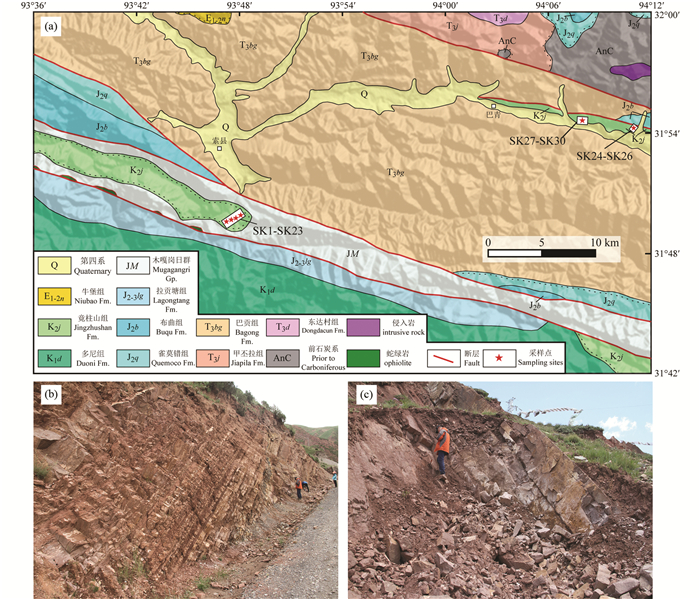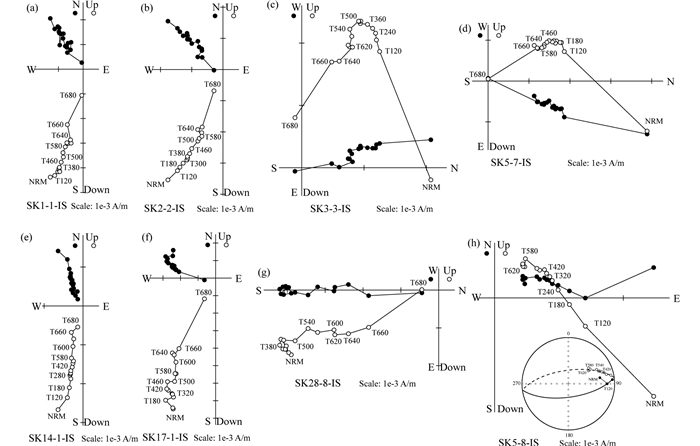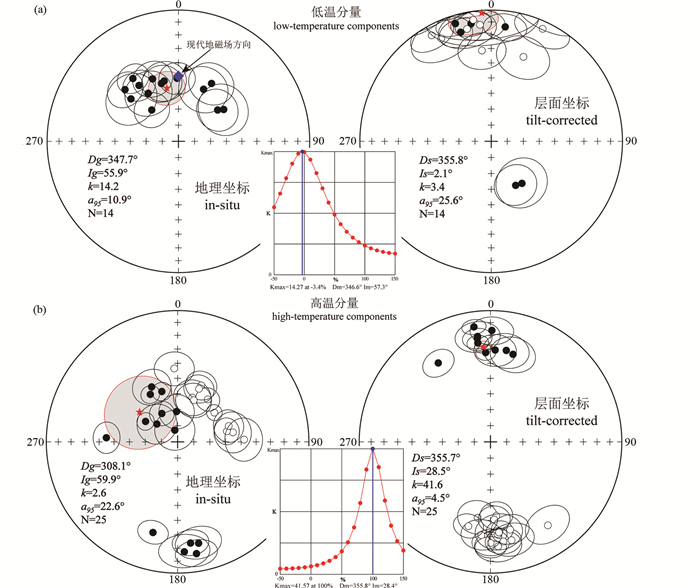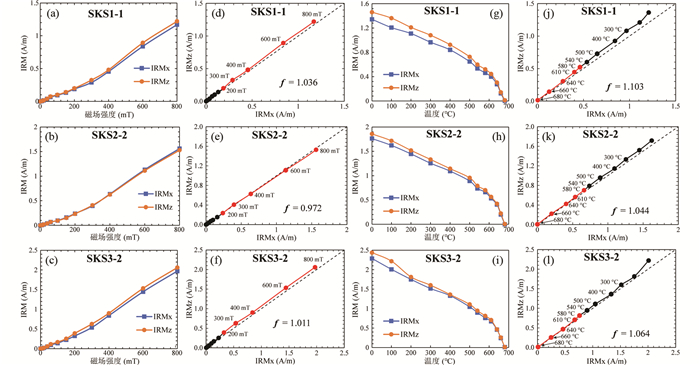2. 中国地质科学院地质研究所, 自然资源部深地动力学重点实验室, 北京 100037;
3. 南方海洋科学与工程广东省实验室(广州), 广州 511458;
4. 陕西工程勘察研究院有限公司, 西安 710068
2. MNR Key Laboratory of Deep-Earth Dynamics, Institute of Geology, Chinese Academy of Geological Sciences, Beijing 100037, China;
3. Southern Marine Science and Engineering Guangdong Laboratory(Guangzhou), Guangzhou 511458, China;
4. Shaanxi Institute of Engineering Prospecting, Xi'an 710068, China
青藏高原形成和演化是地学界最热门的研究课题之一。印度板块和拉萨地块自冈瓦纳大陆裂解后向北漂移,并最终碰撞-拼合至亚洲大陆南缘。由于拉萨与羌塘地块在侏罗-白垩纪以及印度与亚洲大陆在早新生代的先后碰撞,导致白垩纪以来亚洲大陆内部发生了大量的构造缩短和构造旋转作用,对青藏高原内部变形和隆升产生了重要的影响(Patriat and Achache, 1984;Murphy et al., 1997;Yin and Harrison, 2000;DeCelles et al., 2002;Kapp et al., 2007;van Hinsbergen et al., 2011;Li et al., 2015;Yan et al., 2016)。因此,定量约束亚洲大陆内部构造缩短对探讨青藏高原的形成和演化具有重要意义。
地质证据表明拉萨地块与羌塘地块碰撞所造成的显著构造缩短主要发生在早白垩世时期(Murphy et al., 1997;Kapp et al., 2007),那么晚白垩世以来亚洲大陆内部的构造缩短应该主要是由印度与亚洲大陆碰撞所致。但现有地质资料对印度与亚洲大陆碰撞所导致亚洲大陆内部构造缩短量的约束存在较大争议。Yin and Harrison(2000)提出印度与亚洲大陆碰撞以来至少有~1360km的南北向构造缩短被喜马拉雅-青藏高原造山带所吸收;Li et al.(2015)综合分析地质资料认为~55Ma以来印度与亚洲大陆之间发生了~1630km的构造缩短,而在亚洲大陆内部的构造缩短量为~1010km;但van Hinsbergen et al.(2011)认为亚洲大陆内部不同地区构造缩短量并不一致,西部、中部和东部构造缩短量分别为~1050km、~750km和~600km。
古地磁学在板块古纬度位置重建方面有独特的优势,将所获得的古纬度实测值与期望值对比可以定量约束板块内部构造缩短量。前人根据拉萨地块和羌塘地块晚白垩世古地磁研究对亚洲大陆内部南北向构造缩短进行了探讨,但其结果存在较大分歧。如拉萨地块中部南缘晚白垩世古地磁研究表明印度与亚洲大陆碰撞以来亚洲大陆南缘与亚洲大陆刚性块体之间产生了1500±830km的构造缩短(Sun et al., 2012);拉萨地块西缘古地磁结果显示晚白垩世以来拉萨地块西缘与亚洲大陆刚性块体之间的构造缩短量为1500±800km(Ma et al., 2017);而拉萨地块林周盆地古地磁研究结果显示晚白垩以来亚洲大陆内部的构造缩短量为1040~1200km(Cao et al., 2017;梁雅伦等,2017),该结果与拉萨地块东北缘晚白垩世古地磁研究所揭示的印度与亚洲大陆碰撞以来亚洲大陆内部构造缩短量较为一致(Tong et al., 2017);但也有学者提出较小的构造缩短量,如拉萨地块措勤地区晚白垩世古地磁研究显示印度与亚洲大陆碰撞导致亚洲大陆内部构造缩短量仅为780±240km(Yang et al., 2015);羌塘地块双湖地区晚白垩世古地磁结果表明印度与亚洲大陆碰撞导致青藏高原中部与蒙古地体之间发生了830±320km的构造缩短(Meng et al., 2018)。此外,也有学者的古地磁研究结果显示印度与亚洲大陆碰撞后亚洲大陆内部并未产生明显的构造缩短(Tan et al., 2010;Meng et al., 2012;Huang et al., 2013)。
从以上分析可以看出,现有古地磁研究所揭示自印度与亚洲大陆碰撞以来亚洲大陆内部从无明显构造缩短至存在约2000km的构造缩短不等。拉萨地块内部构造缩短发生的时间主要集中在早白垩世(Murphy et al., 1997;Kapp et al., 2007),那么印度与亚洲大陆碰撞所导致亚洲大陆内部南北向构造缩短应主要集中在拉萨地块以北的区域(Sun et al., 2012;曹勇等,2017)。因此,本文选择位于拉萨地块北部的班公湖-怒江缝合带(图 1)开展详细的古地磁研究,以限定其晚白垩世的古纬度位置,为探讨亚洲大陆内部构造缩短提供古地磁学定量约束。

|
图 1 青藏高原及其周缘构造简图(a, 据Cao et al., 2019修改)及班公湖-怒江缝合带及其邻区地质简图(b, 据耿全如等,2011修改) Fig. 1 Tectonic framework of the Tibetan Plateau and its adjacent region (a, modified after Cao et al., 2019) and sketched geological map along the Bangong-Nujiang suture zone and its adjacent region (b, modified after Geng et al., 2011) |
班公湖-怒江缝合带是青藏高原上板块碰撞拼合的主要构造界线之一,由其南侧的拉萨地块与北部的羌塘地块碰撞而形成(图 1a)(Yin and Harrison, 2000;潘桂棠等,2004;Zhang et al., 2012;Zhu et al., 2016)。班公湖-怒江缝合带东西长约2000km,其北部边界为班公湖-康托-兹格塘错-安多-丁青雪拉山断裂,南部边界为日土-改则-尼玛-丁青断裂(图 1b)(耿全如等,2011)。尽管目前地学界对拉萨地块与羌塘地块的碰撞时限仍存在争议,但是绝大多数证据均表明两地块的碰撞发生在晚白垩世之前(Dewey et al., 1988;丁林和来庆洲,2003;Kapp et al., 2005, 2007;莫宣学和潘桂棠,2006;Yan et al., 2016;Zhu et al., 2016;Guo et al., 2019;Li et al., 2019)。
班公湖-怒江缝合带主要由蛇绿混杂岩和中生代地层组成,缝合带内蛇绿岩的形成年代为~190Ma至~110Ma(Zhang et al., 2012;Xu et al., 2015;Chen et al., 2018),中生代地层主要包括确哈拉群(J3Q)、木嘎岗日岩群(JM)、沙木罗组(J3-K1s)、去申拉组(K1q)和竟柱山组(K2j)(Guo et al., 2019)。确哈拉群和木嘎岗日岩群为弧前深水盆地复理石沉积,沙木罗组为洋盆闭合过程中形成的残余盆地沉积,去申拉组为洋盆闭合过程中形成的火山弧(耿全如等,2011),竟柱山组为河流相、湖泊相沉积地层,主要沿缝合带及其两侧呈近东西向线性分布(李华亮等,2016)。
研究区位于班公湖-怒江缝合带东段索县地区,该段缝合带呈北西-南东向展布(图 1b,图 2a),并发育与缝合带相关的蛇绿岩套及其后沉积的海、陆相地层。研究区内发育一套竟柱山组紫红色沉积地层,岩性主要为粉砂岩、砂岩和砂质砾岩,部分层位夹泥岩。区域上该红层中产有孔虫(Nonion cf. sichuanensis Li)和介形虫化石(Cyclocypris sp., Cyprois sp., Eucypris sp., Physocypria sp.),化石时代为晚白垩世至始新世;因这一红层上覆上白垩统八达组,因此限定研究区竟柱山组红层的形成时代为晚白垩世(西藏自治区地质调查院,2005①)。
① 西藏自治区地质调查院. 2005.中华人民共和国区域地质调查报告比如县幅(H46C001003)

|
图 2 班公湖-怒江缝合带东段索县地区地质简图(a,据西藏自治区地质调查院,2005修改)和研究剖面晚白垩世红层部分野外出露及采样照片(b、c) Fig. 2 Geological map of the Suoxian area in the eastern part of the Bangong-Nujiang suture zone (a) and photographs showing some field outcrops and sampling sites of the Late Cretaceous red beds (b, c) |
本次研究在索县地区(31.9°N、93.8°E)采集了30个采点共约298块古地磁样品,其中SK1至SK23采点位于索县县城南约6km处,SK24至SK30采点位于巴青县城东部约10km处。研究剖面晚白垩世竟柱山组红层岩性主要为粉砂岩、砂岩夹泥岩,角度不整合于木嘎岗日岩群之上(图 2)。古地磁样品主要采集自粉砂岩层位。野外使用手持钻机钻取直径为2.54cm的岩心,之后在室内使用双刀切割机加工成2.2cm高的标准古地磁样品。
2 岩石磁学测试及结果本次研究选取了代表样品进行三轴等温剩磁及其热退磁和磁滞回线等岩石磁学测试。三轴等温剩磁及其热退磁测试首先对样品的Z轴、Y轴和X轴分别施加2.5T、0.4T和0.12T的磁场,然后进行系统热退磁(Lowrie,1990)。另外,选取代表样品研磨至粉末状,使用Lake Shore 8600系列振动样品磁强计进行磁滞回线测试。根据磁滞回线测试获得了代表样品的饱和磁化强度(Ms)、饱和剩磁强度(Mr)、矫顽力(Hc)和剩磁矫顽力(Hcr)值。以上岩石磁学测试均在自然资源部古地磁与古构造重建重点实验室内进行。
代表样品的三轴等温剩磁系统热退磁结果见图 3。研究剖面代表样品的硬磁成份和中间磁成份的剩磁强度随温度升高逐渐衰减,至680℃时其剩磁强度衰减至接近为零(图 3),揭示了样品中赤铁矿的解阻。样品的软磁成份的剩磁强度在580℃时衰减至接近为零(图 3),揭示了样品中磁铁矿的解阻。以上结果表明本次研究样品中的主要载磁矿物为赤铁矿,可能有少量的磁铁矿。代表样品的磁滞回线在~2T的外加磁场下接近闭合,且样品的Hc和Hcr值较大,表明样品中高矫顽力磁性矿物占主导,这与三轴等温剩磁及其热退磁显示的赤铁矿相对应。而样品的磁滞回线形态呈“鹅颈形”(图 4a-d),表明其主要载磁矿物为赤铁矿和单畴磁铁矿的混合物(Tauxe et al., 2010)。以上岩石磁学结果表明本次研究班公湖-怒江缝合带东段晚白垩世红层样品中的主要载磁矿物为赤铁矿和磁铁矿。

|
图 3 班公湖-怒江缝合带索县地区晚白垩世红层代表样品三轴等温剩磁系统热退磁结果图 Fig. 3 Results of thermal demagnetization of the three-component isothermal remanent magnetization of representative samples for the Late Cretaceous red beds in the Suoxian area of the Bangong-Nujiang suture zone |

|
图 4 班公湖-怒江缝合带索县地区晚白垩世红层代表样品磁滞回线结果图 Fig. 4 Hysteresis loops of representative samples for the Late Cretaceous red beds in the Suoxian area of the Bangong-Nujiang suture zone |
野外采集的岩心样品经室内加工成标准古地磁样品后均进行系统热退磁实验。古地磁样品首先进行天然剩磁(NRM)测量,然后使用TD-48热退磁炉进行系统热退磁。样品加热温度间隔在低温段为40~50℃,高温段为20~30℃。样品的剩磁使用2G-755R超导磁力仪测量。系统热退磁及剩磁测量在自然资源部古地磁与古构造重建重点实验室磁屏蔽屋内进行。磁屏蔽屋内的磁场 < 300nT,排除了外界磁场对样品测试数据的影响。
研究剖面样品的系统热退磁结果显示部分样品在NRM至240℃之间存在一低温剩磁分量(图 5c, d, f, g)。本次研究从14个采点样品中分离出低温剩磁分量,其平均方向为Dg=347.7°、Ig=55.9°、κg=14.2、α95=10.9°(地理坐标下);Ds=355.8°、Is=2.1°、κs=3.4、α95=25.6°(层面坐标下)(表 1、图 6a)。该低温分量逐步展平检验结果显示其k值在-3.4%展平度时最大为14.27(Watson and Enkin, 1993)。地理坐标下低温分量的平均值与采样点现代地磁场方向(D/I=0.1°/48.8°)接近(图 6a),表明其很可能为近现代地磁场的粘滞剩磁。

|
图 5 班公湖-怒江缝合带索县地区晚白垩世红层代表样品Z矢量图(地理坐标下) Fig. 5 Representative orthogonal vector diagrams (in geographic coordinates) for the Late Cretaceous red beds in the Suoxian area of the Bangong-Nujiang suture zone |
|
|
表 1 班公湖-怒江缝合带晚白垩世红层高温特征剩磁分量结果统计表 Table 1 Site-Mean paleomagnetic directions of the high-temperature components of the Late Cretaceous red beds in the Bangong-Nujiang suture zone |

|
图 6 班公湖-怒江缝合带索县地区晚白垩世红层低温分量(a)和高温分量(b)等面积投影图及褶皱逐步展平检验结果图 Fig. 6 Equal-area projections and the progressive unfolding analysis of low-temperature (a) and high-temperature (b) components directions for the Late Cretaceous red beds in the Suoxian area of the Bangong-Nujiang suture zone |
研究剖面中大部分样品在~300℃至~680℃之间可分离出高温剩磁分量,高温分量随着温度的升高逐渐趋向于原点(图 5a-g),这类样品通过主向量分析法获得其特征剩磁方向(Kirschvink, 1980)。但是部分样品的高温分量随着温度的升高并不趋向于原点,在等面积投影图上呈大圆弧特征分布(图 5h),这类样品的特征剩磁方向通过重磁化大圆弧法获得(Halls,1978)。采点SK24、SK25和SK26未获得稳定的高温特征剩磁分量;采点SK11、SK12、SK16和SK17因获得高温分量的样品数较少,因此将相邻的采点SK11、SK12和SK16、SK17分别合并进行数据统计。经数据分析获得了研究剖面25个采点的高温特征剩磁分量,其平均磁化方向为:Dg=308.1°、Ig=59.9°、κg=2.6、α95=22.6°(地理坐标下);Ds=355.7°、Is=28.5°、κs=41.6、α95=4.5°(层面坐标下)(表 1)。该剖面数据在95%和99%置信区间内均通过褶皱检验(ξc在95%置信区间为5.82,在99%置信区间为8.175;地理坐标下ξin-situ=17.92,构造校正后ξtilt-corrected=2.206)(McFadden,1990)。且该高温分量逐步展平检验结果显示其k值在100%展平度时最大(Watson and Enkin, 1993)。另外,索县剖面获得的高温特征剩磁方向具有正、反双极性(图 6b),倒转检验结果为r=5.2° < rc=9.3°,通过B级倒转检验(McFadden and McElhinny, 1990)。
4 磁倾角浅化试验青藏高原中、新生代部分红层沉积物在岩石形成过程中可能因压实作用而导致其记录的磁倾角发生浅化现象(Tan et al., 2010;Huang et al., 2013;Lippert et al., 2014;Chen et al., 2017;Meng et al., 2018;Yang et al., 2019)。因此,有效评估所研究的红层样品是否遭受磁倾角浅化作用对古地磁数据可靠性的判别具有重要意义。目前,主要有两种方法判断岩石记录的磁倾角是否遭受浅化作用:一种是等温剩磁各向异性分析方法(Hodych and Buchan, 1994),另一种是E/I (Elongation/Inclination)矫正方法(Tauxe and Kent, 2004)。局部构造旋转作用可能会导致不同采点间的古地磁数据存在一定的偏角差异,在此种情况下运用E/I方法对倾角浅化进行矫正所获得的浅化因子(f)会有所偏差(Tong et al., 2015, 2017;Yang et al., 2019)。因此,本次研究采用等温剩磁各向异性分析方法对所研究样品记录的磁倾角是否发生浅化进行评估。
本次研究共对3个采点9块样品进行等温剩磁各向异性分析,具体方法见Hodych and Buchan(1994),等温剩磁各向异性分析结果见表 2和图 7。本次研究红层样品在外加磁场200mT至800mT之间垂直岩层面(IRMz)与平行岩层面(IRMx)的等温剩磁强度比值的平均值为1.014,标准偏差为0.033;在等温剩磁系统热退磁580℃至680℃之间IRMz/IRMx平均值为1.063,标准偏差为0.057。样品在等温剩磁外加磁场200mT至800mT之间IRMz/IRMx比值与等温剩磁系统热退磁580℃至680℃之间IRMz/IRMx比值较为一致。等温剩磁系统热退磁580℃至680℃之间获得的IRMz/IRMx值浅化因子(f)为1.063,表明本次研究班公湖-怒江缝合带晚白垩世红层不存在磁倾角浅化现象。
|
|
表 2 班公湖-怒江缝合带晚白垩世红层样品等温剩磁各向异性分析结果 Table 2 Anisotropy of isothermal remanent magnetization of the Late Cretaceous red beds of the Bangong-Nujiang suture zone |

|
图 7 班公湖-怒江缝合带索县地区晚白垩世红层代表样品磁倾角浅化试验结果图 (a-c)沿层面45°夹角方向逐步加场过程中IRMx和IRMz变化对比图;(d-f)沿层面45°方向逐步加场过程中IRMz/IRMx数值变化图;(g-i)热退磁过程中IRMx和IRM变化对比图;(j-l)热退磁过程中IRMz/IRMx数值变化图 Fig. 7 Test results of inclination shallowing for the Late Cretaceous red beds in the Suoxian area of the Bangong-Nujiang suture zone (a-c) plots of IRMx and IRMz acquisitions produced by applying magnetic field at an angle of 45° to the bedding as a function of increasing field; (d-f) the slope (IRMz/IRMx) of the least-squares-fit for data points between 200mT and 800mT; (g-i) plots of IRMx and IRMz acquisitions produced by thermal demagnetization; (g-l) the results of IRMz/IRMx and the slope (IRMz/IRMx) of the least-squares-fit for data points between 580℃ and 680℃ |
班公湖-怒江缝合带作为青藏高原的重要构造界线,其古地理位置演化对重建青藏高原古地理格局和探讨青藏高原形成的动力学过程具有重要意义。本次研究从班公湖-怒江缝合带东段索县地区晚白垩世红层25个有效采点中获得的古地磁结果为:Dg=308.1°、Ig=59.9°、κg=2.6、α95=22.6°(地理坐标下);Ds=355.7°、Is=28.5°、κs=41.6、α95=4.5°(层面坐标下)。该结果通过褶皱检验和倒转检验,且磁倾角浅化试验结果显示本次研究地层不存在磁倾角浅化现象。以上证据表明本次研究从班公湖-怒江缝合带东段晚白垩世红层中获得的古地磁结果应为岩石形成时的原生剩磁,其值可为班公湖-怒江缝合带晚白垩世古纬度位置提供可靠的古地磁约束。
通过班公湖-怒江缝合带东段晚白垩世红层中高温特征剩磁分量平均磁化方向获得相应的古地磁极为72.8°N、288.0°E、dp/dm=2.7°/4.9°,据此限定了班公湖-怒江缝合带东段晚白垩世的古纬度为15.2±3.7°N(参考点:31.9°N/93.8°E)。班公湖-怒江缝合带在晚白垩世之前由拉萨地块与羌塘地块的碰撞伴随着班公湖-怒江特提斯洋的闭合而形成(Dewey et al., 1988;丁林和来庆洲,2003;Kapp et al., 2005, 2007;莫宣学和潘桂堂,2006;Zhang et al., 2012;Zhu et al., 2016;Li et al., 2019)。本次研究获得的班公湖-怒江缝合带晚白垩世古地磁极与拉萨地块东部(Tong et al., 2017)、中部(Tan et al., 2010;Sun et al., 2012;Cao et al., 2017)和西部(Yi et al., 2015)晚白垩世古地磁极在误差范围内重叠(图 8),这表明班公湖-怒江缝合带在晚白垩世时期就与拉萨地块在动力学意义上为一整体。但与拉萨地块部分古地磁结果存在一定的偏角差(图 8),这可能是由于这些地区存在局部构造旋转所致。

|
图 8 班公湖-怒江缝合带、羌塘地块和拉萨地块晚白垩世古地磁极等面积投影图 Fig. 8 Equal-area projection of the Late Cretaceous paleomagnetic poles of the Bangong-Nujiang suture zone, Qiagntang block, and Lhasa block |
本次研究揭示班公湖-怒江缝合带东段晚白垩世的古纬度为15.2±3.7°N,根据亚洲大陆晚白垩世(70~90Ma)参考极的平均极79.0°N、216.2°E、A95=1.8°(Cogné et al., 2013)(表 3),得出班公湖-怒江缝合带晚白垩世古纬度的期望值为25.6±1.8°N(参考点:31.9°N/93.8°E)。这一结果表明班公湖-怒江缝合带东段晚白垩世古纬度期望值与实测值存在10.4°±3.0°的古纬度差,表明晚白垩世以来班公湖-怒江缝合带(94°E经度方向上)与亚洲大陆刚性块体之间发生了约1150±330km的南北向构造缩短。同样,将本次研究获得的班公湖-怒江缝合带东段晚白垩世古地磁极与拉萨地块南缘可靠古地磁极对比(Tan et al., 2010;Sun et al., 2012;Cao et al., 2017),显示两个构造单元晚白垩世古地磁极在误差范围内重叠(图 8),表明晚白垩世以来拉萨地块南缘与班公湖-怒江缝合带之间并不存在明显的构造缩短。这与地质资料所显示的拉萨地块新生代并未发生显著的南北向构造缩短相吻合(Murphy et al., 1997;Yin and Harrison, 2000)。因此,印度与亚洲大陆碰撞所造成的亚洲大陆内部构造缩短主要集中在班公湖-怒江缝合带以北的区域,缩短量为约1150±330km。
|
|
表 3 班公湖-怒江缝合带、羌塘地块和拉萨地块晚白垩世古地磁极统计表 Table 3 Late Cretaceous paleomagnetic poles of the Bangong-Nujiang suture zone, Qiangtang block, and Lhasa block |
地质资料表明羌塘地块和班公湖-怒江缝合带自印度与亚洲大陆碰撞以来发生了>300km的构造缩短(Kapp et al., 2005, 2007;DeCelles et al., 2007;Li et al., 2015)。根据平衡剖面的研究,风火山和玉树-囊谦地区新生代以来的缩短率为~43%(Wang et al., 2002;Spurlin et al., 2005),由此推断松潘-甘孜地块的缩短量为~200km(van Hinsbergen et al., 2011;Li et al., 2015)。通过综合分析柴达木盆地和祁连山-南山逆冲带地质资料,Li et al.(2015)提出柴达木-祁连山-南山地区始新世以来发生了~520km的构造缩短,其中柴达木盆地的构造缩短量为~170km,祁连山-南山逆冲带的构造缩短量为~350km。另外,西天山和蒙古地区的构造缩短分别为>20km和~50km(van Hinsbergen et al., 2011)。综合以上地质资料限定的亚洲大陆内部不同构造单元所发生的南北向构造缩短量至少为~1090km(图 9)。这一构造缩短量与本次古地磁研究所限定的晚白垩世以来班公湖-怒江缝合带(94°E经度方向上)与亚洲大陆刚性块体之间的构造缩短量(1150±330km)吻合。

|
图 9 地质资料与古地磁数据限定亚洲大陆内部构造缩短量对比(据Lippert et al., 2011; Meng et al., 2018修改) Fig. 9 The comparison of crustal shortening within Asia since the Late Cretaceous constrained by geologically and paleomagnetically (modified after Lippert et al., 2011 and Meng et al., 2018) |
本次研究从班公湖-怒江缝合带东段索县地区晚白垩世红层中获得的25个有效采点的特征剩磁方向,其通过褶皱检验和倒转检验,表明其可能为原生剩磁方向。25个采点的古地磁平均向为Ds=355.7°、Is=28.5°、κs=41.6、α95=4.5°,相应的古地磁极位置为相应的古地磁极位置为72.8°N、288.0°E、dp/dm=2.7°/4.9°。等温剩磁各向异性分析表明本次研究晚白垩世红层所记录的特征剩磁方向并未经历明显的磁倾角浅化。这一结果限定了班公湖-怒江缝合带东段晚白垩世的古纬度为15.2±3.7°N(参考点:31.9°N/93.8°E)。通过对比拉萨、羌塘地块古地磁数据和亚洲大陆参考极显示,晚白垩世以来班公湖-怒江缝合带与拉萨地块南缘之间并不存在明显的构造缩短,与亚洲大陆刚性块体之间发生了约1150±330km的南北向构造缩短。这一结果与地质资料限定印度与亚洲大陆碰撞所造成亚洲大陆内部构造缩短量吻合。
致谢 感谢杨天水教授、颜茂都研究员和编辑部俞良军老师对论文提出的宝贵意见和建议;感谢赵越老师在实验测试过程中给于的帮助。
Bian WW, Yang TS, Jiang ZL, Jin JJ, Gao F, Wang S, Peng WX, Zhang SH, Wu HC, Li HY, Cao LW and Deng CL. 2020. Paleomagnetism of the Late Cretaceous red beds from the far western Lhasa Terrane: Inclination discrepancy and tectonic implications. Tectonics, 39(8): e2020TC006280 |
Cao Y, Sun ZM, Li HB, Pei JL, Jiang W, Xu W, Zhao LS, Wang LZ, Li CL, Ye XZ and Zhang L. 2017. New Late Cretaceous paleomagnetic data from volcanic rocks and red beds from the Lhasa terrane and its implications for the paleolatitude of the southern margin of Asia prior to the collision with India. Gondwana Research, 41: 337-351 DOI:10.1016/j.gr.2015.11.006 |
Cao Y, Sun ZM, Liu DL, Zhang L, Ye XZ, Zheng Y and He XL. 2017. Late Cretaceous paleomagnetic results in the Nyima area from the northern margin of the Lhasa block and its tectonic implications. Acta Petrologica Sinica, 33(12): 3989-3998 (in Chinese with English abstract) |
Cao Y, Sun ZM, Li HB, Pei JL, Liu DL, Zhang L, Ye XZ, Zheng Y, He XL, Ge CL and Jiang W. 2019. New paleomagnetic results from Middle Jurassic limestones of the Qiangtang terrane, Tibet: Constraints on the evolution of the Bangong-Nujiang Ocean. Tectonics, 38(1): 215-232 DOI:10.1029/2017TC004842 |
Chen WW, Zhang SH, Ding JK, Zhang JH, Zhao XX, Zhu LD, Yang WG, Yang TS, Li HY and Wu HC. 2017. Combined paleomagnetic and geochronological study on Cretaceous strata of the Qiangtang terrane, central Tibet. Gondwana Research, 41: 373-398 DOI:10.1016/j.gr.2015.07.004 |
Chen WY, Hu XC, Zhong Y, Fu YB, Li F and Wang YG. 2018. Comment on "Sedimentary and tectonic evolution of the Southern Qiangtang Basin: Implications for the Lhasa-Qiangtang collision timing" by Ma A. et al. Journal of Geophysical Research: Solid Earth, 123(9): 7338-7342
|
Cogné JP, Besse J, Chen Y and Hankard F. 2013. A new Late Cretaceous to Present APWP for Asia and its implications for paleomagnetic shallow inclinations in Central Asia and Cenozoic Eurasian plate deformation. Geophysical Journal International, 192(3): 1000-1024 DOI:10.1093/gji/ggs104 |
DeCelles PG, Robinson DM and Zandt G. 2002. Implications of shortening in the Himalayan fold-thrust belt for uplift of the Tibetan Plateau. Tectonics, 21(6): 1062 |
DeCelles PG, Kapp P, Ding L and Gehrels GE. 2007. Late Cretaceous to Middle Tertiary basin evolution in the central Tibetan Plateau: Changing environments in response to tectonic partitioning, aridification, and regional elevation gain. GSA Bulletin, 119(5-6): 654-680 DOI:10.1130/B26074.1 |
Dewey JF, Shackleton RM, Chang CF and Sun YY. 1988. The tectonic evolution of the Tibetan Plateau. Philosophical Transactions of the Royal Society A: Mathematical, Physical and Engineering Sciences, 327(1594): 379-413 |
Ding L and Lai QZ. 2003. New geological evidence of crustal thickening in the Gangdese block prior to the Indo-Asian collision. Chinese Science Bulletin, 48(15): 1604-1610 DOI:10.1007/BF03183969 |
Geng QR, Pan GT, Wang LQ, Peng ZM and Zhang Z. 2011. Tethyan evolution and metallogenic geological background of the Bangong Co-Nujiang belt and the Qiangtang massif in Tibet. Geological Bulletin of China, 30(8): 1261-1274 (in Chinese with English abstract) |
Guo RH, Li SZ, Yu SY, Dai LM, Liu YJ, Peng YB, Zhou ZZ, Wang YH, Liu YM and Wang Q. 2019. Collisional processes between the Qiangtang Block and the Lhasa Block: Insights from structural analysis of the Bangong-Nujiang Suture Zone, central Tibet. Geological Journal, 54(2): 946-960 DOI:10.1002/gj.3420 |
Halls HC. 1978. The use of converging remagnetization circles in palaeomagnetism. Physics of the Earth and Planetary Interiors, 16(1): 1-11 DOI:10.1016/0031-9201(78)90095-X |
Hodych JP and Buchan KL. 1994. Early Silurian palaeolatitude of the Springdale Group red beds of central Newfoundland: A palaeomagnetic determination with a remanence anisotropy test for inclination error. Geophysical Journal International, 117(3): 640-652 DOI:10.1111/j.1365-246X.1994.tb02459.x |
Huang KN, Opdyke ND, Li JG and Peng XJ. 1992. Paleomagnetism of Cretaceous rocks from eastern Qiangtang terrane of Tibet. Journal of Geophysical Research: Solid Earth, 97(B2): 1789-1799 DOI:10.1029/91JB02747 |
Huang WT, Dupont-Nivet G, Lippert PC, van Hinsbergen DJJ and Hallot E. 2013. Inclination shallowing in Eocene Linzizong sedimentary rocks from Southern Tibet: Correction, possible causes and implications for reconstructing the India-Asia collision. Geophysical Journal International, 194(3): 1390-1411 DOI:10.1093/gji/ggt188 |
Kapp P, Yin A, Harrison TM and Ding L. 2005. Cretaceous-Tertiary shortening, basin development, and volcanism in central Tibet. GSA Bulletin, 117(7): 865-878 DOI:10.1130/B25595.1 |
Kapp P, DeCelles PG, Gehrels GE, Heizler M and Ding L. 2007. Geological records of the Lhasa-Qiangtang and Indo-Asian collisions in the Nima area of central Tibet. GSA Bulletin, 119(7-8): 917-933 DOI:10.1130/B26033.1 |
Kirschvink JL. 1980. The Least-squares line and plane and the analysis of palaeomagnetic data. Geophysical Journal International, 62(3): 699-718 DOI:10.1111/j.1365-246X.1980.tb02601.x |
Li HL, Gao C, Li ZH, Zhang Z, Peng ZM and Guan JL. 2016. Age and tectonic significance of Jingzhushan Formation in Bangong Lake area, Tibet. Geotectonica et Metallogenia, 40(4): 663-673 (in Chinese with English abstract) |
Li S, Yin CQ, Guilmette C, Ding L and Zhang J. 2019. Birth and demise of the Bangong-Nujiang Tethyan Ocean: A review from the Gerze area of central Tibet. Earth-Science Reviews, 198: 102907 DOI:10.1016/j.earscirev.2019.102907 |
Li YL, Wang CS, Dai JG, Xu GQ, Hou YL and Li XH. 2015. Propagation of the deformation and growth of the Tibetan-Himalayan orogen: A review. Earth-Science Reviews, 143: 36-61 DOI:10.1016/j.earscirev.2015.01.001 |
Liang YL, Huang BC, Yi ZY, Zhang Y, Yan YG and Zhang DH. 2017. Reconnaissance of pre-collisional paleolatitudes of the southern margin of Eurasia: New paleomagnetic results from Upper Cretaceous red beds in the Linzhou basin, Tibet. Chinese Journal of Geophysics, 60(5): 1811-1824 (in Chinese with English abstract) |
Lippert PC, Zhao XX, Coe RS and Lo CH. 2011. Palaeomagnetism and 40Ar/39Ar geochronology of Upper Palaeogene volcanic rocks from Central Tibet: Implications for the Central Asia inclination anomaly, the palaeolatitude of Tibet and post-50Ma shortening within Asia. Geophysical Journal International, 184(1): 131-161 DOI:10.1111/j.1365-246X.2010.04833.x |
Lippert PC, van Hinsbergen DJJ and Dupont-Nivet G. 2014. Early Cretaceous to present latitude of the central proto-Tibetan Plateau: A paleomagnetic synthesis with implications for Cenozoic tectonics, paleogeography, and climate of Asia. In: Nie J, Horton BK and Hoke GD (eds.). Toward An Improved Understanding of Uplift Mechanisms and the Elevation History of the Tibetan Plateau. Geological Society, London, Special Publication, 507(1): 1-21
|
Lowrie W. 1990. Identification of ferromagnetic minerals in a rock by coercivity and unblocking temperature properties. Geophysical Research Letters, 17(2): 159-162 DOI:10.1029/GL017i002p00159 |
Ma YM, Yang TS, Bian WW, Jin JJ, Wang Q, Zhang SH, Wu HC, Li HY, Cao LW, Yuan HF and Ding JK. 2017. Paleomagnetic and geochronologic results of latest Cretaceous lava flows from the Lhasa terrane and their tectonic implications. Journal of Geophysical Research: Solid Earth, 122(11): 8786-8809 DOI:10.1002/2017JB014743 |
Ma YM, Yang TS, Bian WW, Jin JJ, Wang Q, Zhang SH, Wu HC, Li HY and Cao LW. 2018. A stable southern margin of Asia during the Cretaceous: Paleomagnetic constraints on the Lhasa-Qiangtang collision and the maximum width of the Neo-Tethys. Tectonics, 37(10): 3853-3876 DOI:10.1029/2018TC005143 |
McFadden PL. 1990. A new fold test for palaeomagnetic studies. Geophysical Journal International, 103(1): 163-169 DOI:10.1111/j.1365-246X.1990.tb01761.x |
McFadden PL and McElhinny MW. 1990. Classification of the reversal test in palaeomagnetism. Geophysical Journal International, 103(3): 725-729 DOI:10.1111/j.1365-246X.1990.tb05683.x |
Meng J, Wang CS, Zhao XX, Coe R, Li YL and Finn D. 2012. India-Asia collision was at 24°N and 50Ma: Palaeomagnetic proof from southernmost Asia. Scientific Reports, 2(1): 925 DOI:10.1038/srep00925 |
Meng J, Zhao XX, Wang CS, Liu H, Li YL, Han ZP, Liu T and Wang M. 2018. Palaeomagnetism and detrital zircon U-Pb geochronology of Cretaceous red beds from central Tibet and tectonic implications. Geological Journal, 53(5): 2315-2333 DOI:10.1002/gj.3070 |
Mo XX and Pan GT. 2006. From the Tethys to the formation of the Qinghai-Tibet Plateau: Constrained by tectono-magmatic events. Earth Science Frontiers, 13(6): 43-51 (in Chinese with English abstract) |
Murphy MA, Yin A, Harrison TM, Dürr SB, Chen Z, Ryerson FJ, Kidd WSF, Wang X and Zhou X. 1997. Did the Indo-Asian collision alone create the Tibetan plateau?. Geology, 25(8): 719-722 DOI:10.1130/0091-7613(1997)025<0719:DTIACA>2.3.CO;2 |
Pan GT, Zhu DC, Wang LQ, Liao ZL, Geng QR and Jiang XS. 2004. Bangong lake-Nu river suture zone, the northern boundary of Gondwanaland: Evidence from geology and geophysics. Earth Science Frontiers, 11(4): 371-382 (in Chinese with English abstract) |
Patriat P and Achache J. 1984. India-Eurasia collision chronology has implications for crustal shortening and driving mechanism of plates. Nature, 311(5987): 615-621 DOI:10.1038/311615a0 |
Spurlin MS, Yin A, Horton BK, Zhou JY and Wang JH. 2005. Structural evolution of the Yushu-Nangqian region and its relationship to syncollisional igneous activity, east-central Tibet. GSA Bulletin, 117(9-10): 1293-1317 |
Sun ZM, Pei JJ, Li HB, Xu W, Jiang W, Zhu ZM, Wang XS and Yang ZY. 2012. Palaeomagnetism of Late Cretaceous sediments from southern Tibet: Evidence for the consistent palaeolatitudes of the southern margin of Eurasia prior to the collision with India. Gondwana Research, 21(1): 53-63 DOI:10.1016/j.gr.2011.08.003 |
Tan XD, Gilder S, Kodama K, Jiang W, Han YL, Zhang H, Hu HH and Zhou D. 2010. New paleomagnetic results from the Lhasa block: Revised estimation of latitudinal shortening across Tibet and implications for dating the India-Asia collision. Earth and Planetary Science Letters, 293(3-4): 396-404 DOI:10.1016/j.epsl.2010.03.013 |
Tang XD, Huang BC, Yang LK, Yi ZY, Qiao QQ and Chen LW. 2013. Paleomagnetism and Ar-Ar geochronology of Cretaceous volcanic rocks in the Middle Lhasa terrane, China and tectonic implications. Chinese Journal of Geophysics, 56(1): 136-149 (in Chinese with English abstract) |
Tauxe L and Kent DV. 2004. A simplified statistical model for the geomagnetic field and the detection of shallow bias in paleomagnetic inclinations: Was the ancient magnetic field dipolar? In: Channell JET, Kent DV, Lowrie W and Meert JG (eds.). Timescales of the Paleomagnetic Field, Volume 145. Washington, D.C.: American Geophysical Union, 101-115
|
Tauxe L, Butler RF, van der Voo R and Banerjee SK. 2010. Essentials of Paleomagnetism. California: University of California Press, 131-160
|
Tong YB, Yang ZY, Gao L, Wang H, Zhang XD, An CZ, Xu YC and Han ZR. 2015. Paleomagnetism of Upper Cretaceous red-beds from the eastern Qiangtang Block: Clockwise rotations and latitudinal translation during the India-Asia collision. Journal of Asian Earth Sciences, 114: 732-749 DOI:10.1016/j.jseaes.2015.08.016 |
Tong YB, Yang ZY, Pei JL, Wang H, Xu YC and Pu ZW. 2017. Paleomagnetism of the Upper Cretaceous red-beds from the eastern edge of the Lhasa Terrane: New constraints on the onset of the India-Eurasia collision and latitudinal crustal shortening in southern Eurasia. Gondwana Research, 48: 86-100 DOI:10.1016/j.gr.2017.04.018 |
van Hinsbergen DJJ, Kapp P, Dupont-Nivet G, Lippert PC, DeCelles PG and Torsvik TH. 2011. Restoration of Cenozoic deformation in Asia and the size of Greater India. Tectonics, 30(5): TC5003 |
Wang CS, Liu ZF, Yi HS, Liu S and Zhao XX. 2002. Tertiary crustal shortening and peneplanation in the Hoh Xil region: Implications for the tectonic history of the northern Tibetan Plateau. Journal of Asian Earth Sciences, 20(3): 211-223 DOI:10.1016/S1367-9120(01)00051-7 |
Watson GS and Enkin RJ. 1993. The fold test in paleomagnetism as a parameter estimation problem. Geophysical Research Letters, 20(19): 2135-2137 DOI:10.1029/93GL01901 |
Xu W, Li C, Xu MJ, Wu YW, Fan JJ and Wu H. 2015. Petrology, geochemistry, and geochronology of boninitic dikes from the Kangqiong ophiolite: Implications for the Early Cretaceous evolution of Bangong-Nujiang Neo-Tethys Ocean in Tibet. International Geology Review, 57(16): 2028-2043 DOI:10.1080/00206814.2015.1050464 |
Yan MD, Zhang DW, Fang XM, Ren HD, Zhang WL, Zan JB, Song CH and Zhang T. 2016. Paleomagnetic data bearing on the Mesozoic deformation of the Qiangtang Block: Implications for the evolution of the Paleo-and Meso-Tethys. Gondwana Research, 39: 292-316 DOI:10.1016/j.gr.2016.01.012 |
Yang TS, Ma YM, Zhang SH, Bian WW, Yang ZY, Wu HC, Li HY, Chen WW and Ding JK. 2015. New insights into the India-Asia collision process from Cretaceous paleomagnetic and geochronologic results in the Lhasa terrane. Gondwana Research, 28(2): 625-641 DOI:10.1016/j.gr.2014.06.010 |
Yang TS, Jin JJ, Bian WW, Ma YM, Gao F, Peng WX, Ding JK, Wang S, Zhang SH, Wu HC, Li HY and Yang ZY. 2019. Precollisional latitude of the Northern Tethyan Himalaya from the Paleocene red beds and its implication for Greater India and the India-Asia collision. Journal of Geophysical Research: Solid Earth, 124(11): 10777-10798 DOI:10.1029/2019JB017927 |
Yi ZY, Huang BC, Yang LK, Tang XD, Yan YG, Qiao QQ, Zhao J and Chen LW. 2015. A quasi-linear structure of the southern margin of Eurasia prior to the India-Asia collision: First paleomagnetic constraints from Upper Cretaceous volcanic rocks near the western syntaxis of Tibet. Tectonics, 34(7): 1431-1451 DOI:10.1002/2014TC003571 |
Yin A and Harrison TM. 2000. Geologic evolution of the Himalayan-Tibetan orogen. Annual Review of Earth and Planetary Sciences, 28: 211-280 DOI:10.1146/annurev.earth.28.1.211 |
Zhang KJ, Zhang YX, Tang XC and Xia B. 2012. Late Mesozoic tectonic evolution and growth of the Tibetan Plateau prior to the Indo-Asian collision. Earth-Science Reviews, 114(3-4): 236-249 DOI:10.1016/j.earscirev.2012.06.001 |
Zhu DC, Li SM, Cawood PA, Wang Q, Zhao ZD, Liu SA and Wang LQ. 2016. Assembly of the Lhasa and Qiangtang terranes in central Tibet by divergent double subduction. Lithos, 245: 7-17 DOI:10.1016/j.lithos.2015.06.023 |
曹勇, 孙知明, 刘栋梁, 张蕾, 叶小舟, 郑勇, 何祥丽. 2017. 拉萨地块北缘尼玛地区晚白垩世古地磁结果及其构造意义. 岩石学报, 33(12): 3989-3998. |
丁林, 来庆洲. 2003. 冈底斯地壳碰撞前增厚及隆升的地质证据:岛弧拼贴对青藏高原隆升及扩展历史的制约. 科学通报, 48(8): 836-842. |
耿全如, 潘桂棠, 王立全, 彭智敏, 张璋. 2011. 班公湖-怒江带、羌塘地块特提斯演化与成矿地质背景. 地质通报, 30(8): 1261-1274. |
李华亮, 高成, 李正汉, 张璋, 彭智敏, 关俊雷. 2016. 西藏班公湖地区竟柱山组时代及其构造意义. 大地构造与成矿学, 40(4): 663-673. |
梁雅伦, 黄宝春, 易治宇, 张也, 闫永刚, 张东海. 2017. 印欧大陆碰撞前亚洲大陆南缘古位置再研究:林周盆地上白垩统红层的古地磁新结果. 地球物理学报, 60(5): 1811-1824. |
莫宣学, 潘桂棠. 2006. 从特提斯到青藏高原形成:构造-岩浆事件的约束. 地学前缘, 13(6): 43-51. |
潘桂棠, 朱弟成, 王立全, 廖忠礼, 耿全如, 江新胜. 2004. 班公湖-怒江缝合带作为冈瓦纳大陆北界的地质地球物理证据. 地学前缘, 11(4): 371-382. |
唐祥德, 黄宝春, 杨列坤, 易治宇, 乔庆庆, 陈力为. 2013. 拉萨地块中部晚白垩世火山岩Ar-Ar年代学和古地磁研究结果及其构造意义. 地球物理学报, 56(1): 136-149. |
 2020, Vol. 36
2020, Vol. 36


